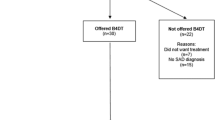Abstract
The present study evaluated the initial effects of two types of paradoxical directives. Socially anxious males were randomly assigned to three groups: symptom prescription without reframing, symptom prescription with reframing, and a wait-list control condition. The assessment of outcome consisted of various measures administered pretreatment, posttreatment, and at 1-month followup, as well as daily self-ratings that were obtained throughout the course of the study. Subjects who were exposed to symptom prescription with reframing showed significantly greater improvement than the subjects in the other groups, both at posttreatment and at followup. In contrast, the subjects who were exposed to symptom prescription alone manifested only limited improvement and were not significantly less socially anxious after treatment than the subjects in the wait-list control group. The findings support the view that paradoxical treatments are clinically useful when their effects include changes in the meaning clients attribute to their symptoms.
Similar content being viewed by others
References
Akillas, E. (1991). Symptom prescription with and without reframing: Relative efficacy of two paradoxical directives in the treatment of socially anxious males (Doctoral dissertation, Temple University, 1991).Dissertation Abstracts International, 52, 1046B.
American Psychiatric Association. (1987).Diagnostic and statistical manual of mental disorders (3rd ed., rev.). Washington, DC: Author.
Ascher, L. M. (1986). Several suggestions for the future of paradox in therapy.The Counseling Psychologist, 14, 291–296.
Ascher, L. M., & Turner, R. M. (1980). A comparison of two methods for the administration of paradoxical intention.Behaviour Research and Therapy, 18, 121–126.
Beck, A. T., Ward, C. H., Mendelson, M., Mock, J., & Erbaugh, J. (1961). An inventory for measuring depression.Archives of General Psychiatry, 4, 561–571.
Cole, D. A., Howard, G. S., & Maxwell, S. E. (1981). Effects of mono- versus multiple-operationalization in construct validation efforts.Journal of Consulting and Clinical Psychology, 3, 395–405.
Dell, P. F. (1981). Some irreverent thoughts on paradox.Family Process, 20, 37–51.
Dell, P. F. (1986). Why do we still call them “paradoxes”?Family Process, 25, 223–234.
Farrell, A. D., Mariotto, M. J., Conger, A. J., Curran, J. P., & Wallander, J. L. (1979). Self-ratings and judges' ratings of heterosexual social anxiety and skill: A generalizability study.Journal of Consulting and Clinical Psychology, 47, 164–175.
Frankl, V. E. (1960). Paradoxical intention: A logotherapeutic technique.American Journal of Psychotherapy, 14, 520–535.
Frankl, V. E. (1985). Paradoxical intention. In G. R. Weeks (Ed.),Promoting change through paradoxical therapy (pp. 99–110). Homewood, IL: Dorsey Professional Books.
Greenhouse, S. W., & Geisser, S. (1959). On methods in the analysis of profile data.Psychometrika 24, 95–112.
Haley, J. (1973).Uncommon therapy: The psychiatric techniques of Milton H. Erickson, M.D. New York: Norton.
Haley, J. (1984).Ordeal therapy: Unusual ways to change behavior. San Francisco: Jossey-Bass.
Hill, K. A. (1987). Meta-analysis of paradoxical interventions.Psychotherapy, 24, 266–270.
Kendall, P. C., & Grove, W. M. (1988). Normative comparisons in therapy outcome.Behavioral Assessment, 10, 147–158.
Kendall, P. C., Hollon, S. D., Beck, A. T., Hammen, C. L., & Ingram, R. E. (1987). Issues and recommendations regarding use of the Beck Depression Inventory.Cognitive Therapy and Research, 11, 289–299.
O'Connell, D. S. (1983). Symptom prescription in psychotherapy.Psychotherapy: Theory, Research and Practice, 20, 12–20.
Reiss, S., Peterson, R. A., & Gursky, D. M. (1988). Anxiety sensitivity, injury sensitivity, and individual differences in fearfulness.Behaviour Research and Therapy, 26, 1–8.
Reiss, S., Peterson, R. A., Gursky, D. M., & McNally, R. J. (1986). Anxiety sensitivity, anxiety frequency and the prediction of fearfulness.Behaviour Research and Therapy, 24, 1–8.
Selvini-Palazzoli, M., Boscolo, L., Cecchin, G., & Prata, G. (1978).Paradox and counterparadox: A new model in the therapy of the family in schizophrenic transaction (E. V. Burt, Trans.). New York: Aronson. (Original work published 1975.)
Shoham-Salomon, V., Avner, R., & Neeman, R. (1989). You're changed if you do and changed if you don't: Mechanisms underlying paradoxical interventions.Journal of Consulting and Clinical Psychology, 57, 590–598.
Shoham-Salomon, V., & Rosenthal, R. (1987). Paradoxical interventions: A meta-analysis.Journal of Consulting and Clinical Psychology, 55, 22–28.
Speilberger, C. D., Gorsuch, R. L., & Lushene, R. E. (1970).Manual for the State-Trait Anxiety Inventory. Palo Alto, CA: Consulting Psychologist Press.
Tennen, H., Rohrbaugh, M., Press, S., & White, L. (1981). Reactance theory and therapeutic paradox: A compliance-defiance model.Psychotherapy: Theory, Research and Practice, 18, 14–22.
Turner, S. M., Beidel, D. C., & Larkin, K. T. (1986). Situational determinants of social anxiety in clinic and nonclinic samples: Physiological and cognitive correlates.Journal of Consulting and Clinical Psychology, 54, 523–527.
Turner, S. M., McCann, B. S., Beidel, D. C., & Mezzich, J. E. (1986). DSM-III classification of the anxiety disorders: A Psychometric study.Journal of Abnormal Psychology, 95, 168–172.
Watson, C. (1985). A Delphi study of paradox in therapy. In G. R. Weeks (Ed.),Promoting change through paradoxical therapy (pp. 2–25). Homewood, IL: Dorsey Professional Books.
Watson, D., & Friend, D. (1969). Measurement of social-evaluative anxiety.Journal of Consulting and Clinical Psychology, 33, 448–457.
Watzlawick, P., Beavin, J., & Jackson, D. D. (1967).Pragmatics of human communication. New York: Norton.
Watzlawick, P., Weakland, J. H., & Fisch, R. (1974).Change: Principles of problem formation and problem resolution. New York: Norton.
Weeks, G. R., & L'Abate, L. (1982).Paradoxical psychotherapy: Theory and practice with individuals, couples, and families. New York: Brunner/Mazel.
Winer, B. J. (1970).Statistical principles in experimental design. New York: McGraw-Hill.
Author information
Authors and Affiliations
Additional information
This article is based in part on a doctoral dissertation completed by the senior author. Alan L. Sockloff provided statistical advice, and Bret Boyer, Chris Combs, Amy Glascott, Alan Lipman, Leslie Parkes, Michael Penn, Lydia Santiago, and Fran Sessa served as therapists.
Rights and permissions
About this article
Cite this article
Akillas, E., Efran, J.S. Symptom prescription and reframing: Should they be combined?. Cogn Ther Res 19, 263–279 (1995). https://doi.org/10.1007/BF02230400
Issue Date:
DOI: https://doi.org/10.1007/BF02230400



